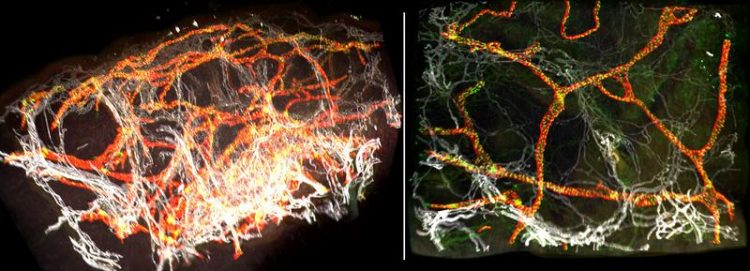New method of analysing lymphoedema – Making digital 3D images of tissue

3D computer reconstruction of a healthy human skin biobsy. Spatial arrangement of blood vessels (white) and lymphatic vessels (red) is distinctly visible. JCI Insight
When researchers and physicians analyse tissue, for example in order to investigate any pathological changes, they often look at the tissue samples under the light microscope. However, producing meaningful images is not always easy.
Researchers at the Cells-in-Motion Cluster of Excellence at the University of Münster and at the Max Planck Institute for Molecular Biomedicine in Münster have now developed a new method which, in the case of lymphoedema, can create digital 3D images of blood vessels and lymphatic vessels of entire tissue biopsies.
This method will help to analyse the underlying changes of the blood and lymphatic vessels in lymphoedema in a more detailed way. “We’re doing a digital three-dimensional histopathology,” explains Dr. René Hägerling, lead author of the study which has just been published in the latest issue of the “JCI Insight” journal.
The process has involved interdisciplinary collaboration between biochemists, chemists, computer scientists, biologists and physicians. The researchers analysed three skin biopsies taken from healthy persons and one skin biopsy of a patient with lymphoedema.
Using light sheet microscopy they produced thousands of individual optical sections for each sample. Using a special programming system called Voreen the researchers assembled the individual optical sections on the computer and produced a three-dimensional reconstruction of the tissue structure.
The new method – called VIPAR – enables researchers for the first time to generate 3D reconstructions of skin biopsies, visualize them and extract characteristic parameters of the tissue. This method differs from traditional histological analyses, in which a tissue sample is sliced into many sections and each individual section is observed two-dimensionally.
Original publication:
Hägerling R, Drees D, Scherzinger A, Dierkes C, Martin-Almedina S, Butz S, Gordon K, Schäfers M, Hinrichs K, Ostergaard P, Vestweber D, Goerge T, Mansour S, Jiang X, Mortimer PS, Kiefer F. VIPAR, a quantitative approach to 3D histopathology applied to lymphatic malformations. JCI Insight 2017;2, DOI 10.1172/jci.insight.93424.
https://www.uni-muenster.de/Cells-in-Motion/newsviews/2017/08-28.html – The detailed story on the Website of the Cells-in-Motion Cluster of Excellence
https://insight.jci.org/articles/view/93424 – Abstract (published in the “JCI Insight” journal)
Media Contact
All latest news from the category: Life Sciences and Chemistry
Articles and reports from the Life Sciences and chemistry area deal with applied and basic research into modern biology, chemistry and human medicine.
Valuable information can be found on a range of life sciences fields including bacteriology, biochemistry, bionics, bioinformatics, biophysics, biotechnology, genetics, geobotany, human biology, marine biology, microbiology, molecular biology, cellular biology, zoology, bioinorganic chemistry, microchemistry and environmental chemistry.
Newest articles

A ‘language’ for ML models to predict nanopore properties
A large number of 2D materials like graphene can have nanopores – small holes formed by missing atoms through which foreign substances can pass. The properties of these nanopores dictate many…

Clinically validated, wearable ultrasound patch
… for continuous blood pressure monitoring. A team of researchers at the University of California San Diego has developed a new and improved wearable ultrasound patch for continuous and noninvasive…

A new puzzle piece for string theory research
Dr. Ksenia Fedosova from the Cluster of Excellence Mathematics Münster, along with an international research team, has proven a conjecture in string theory that physicists had proposed regarding certain equations….



